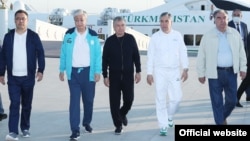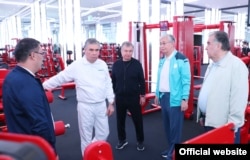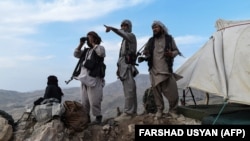
All five Central Asian heads of state gathered at a resort on Turkmenistan's Caspian coast on August 6. And while there was something familiar about their talk of cooperation, new realities lent greater urgency to the discussions.
The meeting in Awaza was already important because it had been so difficult for so long to get all five men in the same room.
Awaza marked their third "consultative meeting" since 2018, although it was the first that did not include Kazakhstan's first president, Nursultan Nazarbaev.
Nazarbaev's successor, Qasym-Zhomart Toqaev, didn't attend the summit in Uzbekistan in November 2019 despite his election five months earlier, but he was on his own for this one.
Also new -- and unavoidable -- at this meeting was discussion of the coronavirus pandemic and the need for cooperation to combat the spread of that virus.
As the five men assembled, a new wave of COVID-19 has been tearing through Kazakhstan, Kyrgyzstan, Tajikistan, and Uzbekistan.
The conversation must have been interesting, since Turkmen President Gurbanguly Berdymukhammedov continues to insist that his country hasn't registered a single case of COVID-19 during the pandemic.
That makes Toqaev's comment that all five leaders supported "the proposal of the president of Turkmenistan on the creation of a [regional] center for virology and epidemiology" a bit surprising.
Also a bit surprising was that the battle against the spread of the coronavirus was point 19 of the 28 points included in the group's joint declaration at the end of the summit.
But the usual talk of improving regional trade took on new meaning as the economies, production, and exports of many countries have been negatively affected by COVID-19 and partners outside the region are less reliable than before the pandemic.
The health crisis affected regional trade, too.
Just prior to the meeting in Turkmenistan, Uzbek and Turkmen officials agreed to renew mutual air and road traffic.
Tajik President Emomali Rahmon arrived early to meet with Berdymukhammedov. Those two succeeded in partially resolving the problem since 2018 of Tajik cargo trucks crossing through Turkmenistan en route to Iran and back.
However, in accordance with rules that Turkmenistan implemented as the scale of the global pandemic was just becoming clear in March 2020, goods arriving at Turkmenistan's borders must be loaded onto Turkmen trucks and carried across the country, then loaded onto vehicles from those goods' ultimate destination.
Toqaev spoke of boosting regional trade and transportation networks and said Kazakhstan could export up to $1 billion in goods to its Central Asian neighbors.
The biggest topic on the agenda, however, was the situation in Afghanistan.
The seventh point of the leaders' joint statement mentioned Afghanistan, where the situation -- especially right across the border from Central Asia -- is more desperate than it has been for at least 20 years.
But their language could have come from any statement in past 30 years.
All five leaders "confirm that one of the most important factors in maintaining and strengthening security and stability in Central Asia is the earliest possible settlement of the situation in neighboring Afghanistan."
And to that end, they "expressed their readiness to render all possible assistance in the earliest possible achievement of civil peace and harmony in Afghan society."
Unfortunately, the three Central Asian states that border Afghanistan are each pursuing different policies toward that country.
Uzbekistan has been speaking with the government and the Taliban and trying to mediate a peace between them.
The Tajik government has avoided communications with the Taliban.
Turkmen authorities are speaking to the Afghan government and the Taliban, but Ashgabat prefers as little involvement in Afghan affairs as possible.
Certainly there was much more said about Afghanistan than what was mentioned in the joint statement. One report noted that Rahmon had warned about "extremists who are well-trained in sabotage, terrorism, and propaganda activities and have far-reaching plans concerning our region."
But arguably the most notable achievement of this latest meeting of the Central Asian Five was the atmosphere, including the sense that they all seemed to be on relatively good terms with each other.
In fact, aside from the formal portion of the meeting when all five men wore suits, it looked more like a party than a summit.
They were photographed in casual clothing going for a boat cruise and wearing sweatsuits in the weight room, prompting Eurasianet's Peter Leonard to write on Twitter that he was "Getting some strong poker night vibes off today's summit of Central Asian presidents." It was an apt assessment of the camaraderie that the five were seemingly trying to project.
That might seem like a trivial matter.
But in the nearly 30 years that those five countries have been independent, their leaders have too often been at odds with each other, even in the face of common threats.














